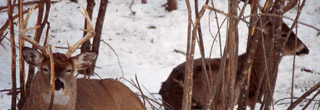It’s noon. After a morning of unsuccessful stand hunting and later hiking along selected deer trails on foot in search of fresh signs made by older bucks, I’m back in my wall tent, large enough to house a pickup. The barrel woodstove in one corner, backed by a neat stack of split deadwood, is popping and crackling, making it warm enough inside to leave my hunting coat hanging outside alongside my rifle slung on the end of an eve pole — one of the nine long spruce poles that make up the gale-resistant framework that supports my cozy wilderness home.

It’s lunch time, generally a quick repast of cold sandwiches and fruit that don’t taint hunting clothes with food odors.
It’s also time to plan the afternoon hunt, aided by memories of new locations of fresh deer signs, a compass and an aerial map of our hunting area overlaid with colored lines that represent the maze of familiar deer trails we use. Before unfolding the map on the table, I take a quit look at smoke billowing from the chimney top outside to check the current wind direction, as vital to our planning and hunting as fresh deer signs. Wherever we decide to stand hunt, we must be able to get there from downwind or crosswind (with the breeze angling toward the front of one cheek). If it can’t be done, no matter how exciting the deer signs at the site might seem, we won’t hunt there, hoping for an opportunity to do it another half-day when the wind direction is favorable and newly made deer signs are again near. Sometimes a stand site that was used a week or a year or more earlier will be near, in which case we’ll use it. Often, however, a usable stand site that provides adequate concealment within easy shooting range downwind or crosswind of fresh signs has never been used before. When not sure the needed perquisites for a proper stand site are available near promising new deer signs, the site is reserved for afternoon and evening hunting only when a suitable stand site can be located without noisily bungling about in darkness with a flashlight in hand. A nearly-silent approach through well masked by natural cover is always vital for success. In the dense wilderness forest we hunt, however, rare is an area near promising buck signs that does not provide adequate concealment in several directions and at least one path to get there through a narrow natural opening, an existing deer trail or the back side of an intervening ridge. We make it a rule to look for approach trails that angle toward selected stand site through cover dense enough to provide concealment from deer that might be feeding out on front of a stand site, making it approachable in moonlight or starlit without the aid of a flashlight an hour before sunrise in the morning. Being accustomed to noticing adequate natural blinds immediately following discoveries of fresh buck tracks and/or droppings, sometimes no more than a single six-foot evergreen at a choice location, we generally know exactly how to quietly return to a newly selected in darkness the following morning. Whenever I’m close to an unfamiliar site, but cannot locate it without the use of a flashlight, I sit down on my stool, turn off my flashlight and wait without motion or sound until it becomes just barely light enough to see my destination, after which I quietly tiptoe to the spot.
I’ve rarely been met in the dark by a snorting deer. When it happens, little can be done to alleviate matters except immediately sitting down and avoiding movements for thirty minutes. If the deer deer did not positively identify you as a hunting human, you may yet spot it after it becomes light enough to legally fire at a deer. Curiosity is sometimes fatal to a deer
As first light begins turning black evergreen trees into green evergreen trees near a stand site I’ve never used before, I commonly begin to notice a number of thin twigs and woody stems that are going to make it difficult to find a clear opening through which to fire at a buck standing where I expect it will be when I fire at it. After nothing deer-like is spotted or heard for fifteen minutes or longer, I will generally dig my sharp pruner from the packsack attached to my stool and slowly and silently stand and reach forward to silently snip off enough of those troublesome twigs and stems to create two or three clear shooting windows, usually no larger than 6-9 inches in diameter. I have often been glad I did this and occasionally been sad because I didn’t.
Okay, no more whispering. We are watching that narrow clearcut where that buck with four-inch tracks browsed early this morning. I’m now ready to hunt deer.














